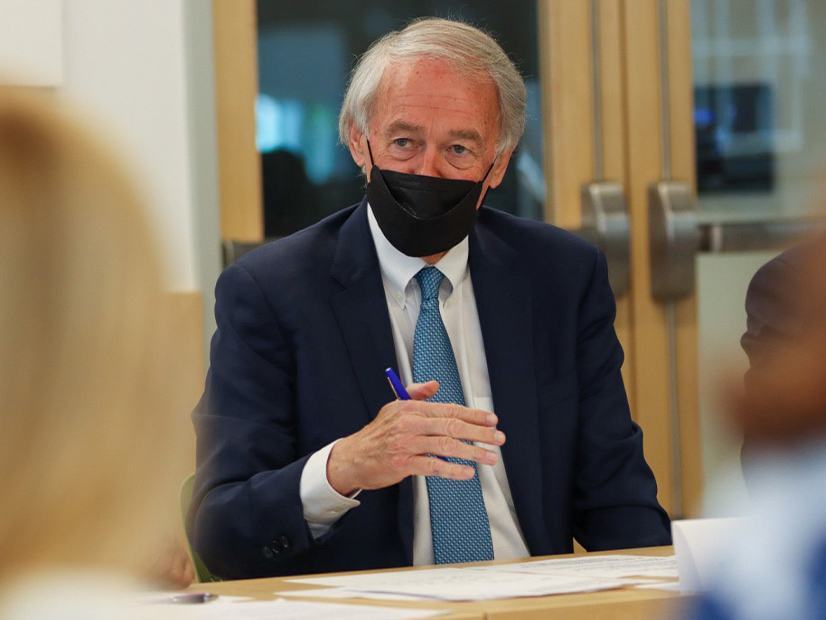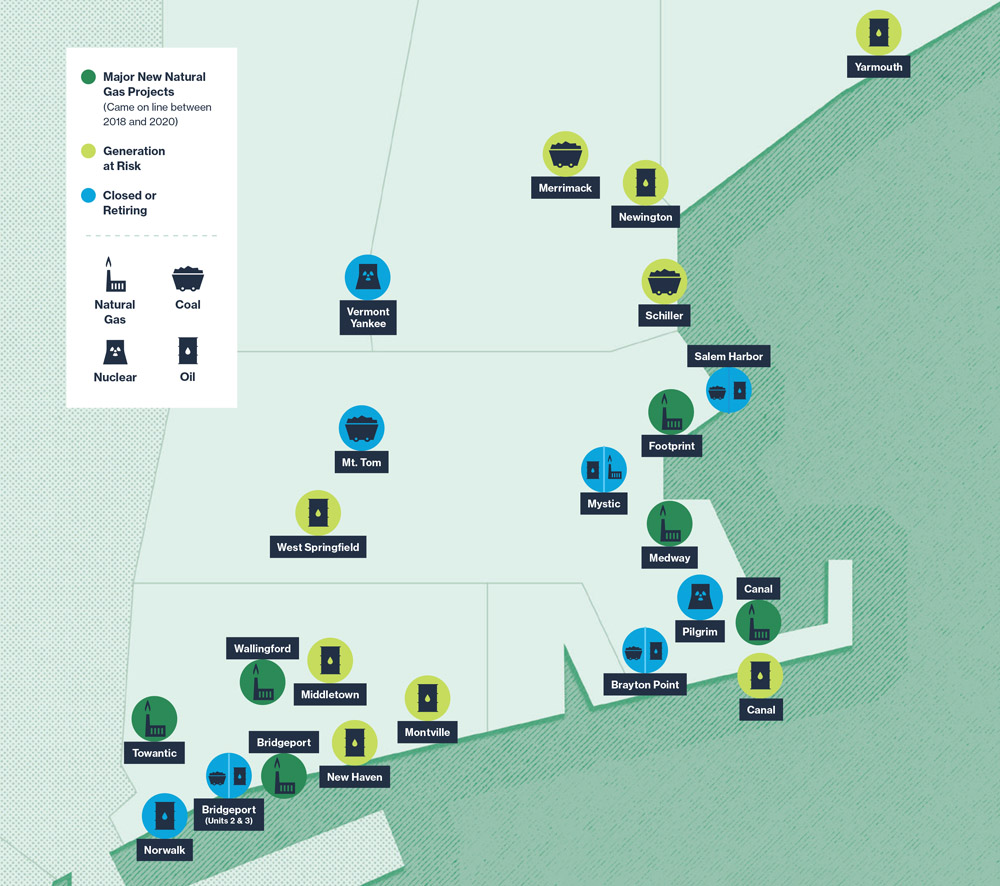
A high-ranking ISO-NE official sat down with some of the RTO’s biggest critics last week, who pushed her on the RTO’s clean energy efforts, market rules and transparency.
Anne George, ISO-NE vice president for external affairs, defended the organization and answered questions lobbed at her by a group of stakeholders in the energy industry and from environmental groups at a roundtable put together by U.S. Sen. Ed Markey (D-Mass.), who himself has offered frequent critiques of the grid operator. (See Mass. Democrats Take on ISO-NE over MOPR.)
“Instead of a renewable energy superhighway for the modern era, our grid is a one-lane road that would still be recognizable to Henry Ford,” Markey said in kicking off the meeting.
He also noted that Massachusetts trails North Dakota in renewable energy generation and that he’s carefully watching news about ISO-NE possibly reviving winter reliability programs to subsidize fossil generators, as well as a FERC investigation into the RTO’s role in capacity market fraud. (See ISO-NE Weighs Reviving Reliability Programs for this Winter and Developer in ISO-NE Hit with FERC Fine for Capacity Market Fraud.)
George said that ISO-NE is “committed to having full conversations with the region” about the markets and decarbonization goals of the states, touting the grid operator’s recent vision statement and its work on the Pathways to the Future Grid study.
Who’s Responsible for Fixing the Markets?
George defended the role of the markets in growing the region’s renewable energy footprint, arguing that siting has been a primary challenge and that states need to step up in finding ways to get projects built.
“There’s a lot that has come on in places where it’s easier to site,” she said.
Another factor George cited: developer recalcitrance.
“Our markets are open to all of these resources to come in. It’s just a question of when the developers want to come in,” she said.
And she repeated a frequent ISO-NE refrain about the importance of natural gas for the region’s near future.
“Natural gas isn’t necessarily an evil thing. It’s providing reliability. It’s oftentimes at lower cost, and it’s going to be here for the foreseeable future. We don’t have enough [clean energy] resources ready to go. They haven’t even tried to come into the market because of their development timelines,” George said.
Greg Cunningham, a vice president at the Conservation Law Foundation, pushed back by noting ISO-NE’s failure to move forward on requests from the states to create a central clean energy mechanism.
“I blanch a little bit when I hear ISO-NE saying the region needs to act,” he said. “The states have, in essence, petitioned ISO-NE to make change, to make it happen. And it’s not. And that’s where principal frustration lies.”
“When we do make a decision, we get criticized,” George shot back. “When we say we’re going to listen to people, we get criticized. At some point, you have to reconcile those positions.”
She reiterated that the RTO has been supportive of a net carbon pricing solution for the region, which would rely primarily on states to enact; the states have been reluctant because of political challenges associated with carbon pricing.
Jeremy McDiarmid, vice president at the Northeast Clean Energy Council, floated a solution at a higher level: add the transition to clean energy to the list of legal responsibilities of RTOs, in addition to maintaining reliability and markets.
“ISO could provide leadership to the states with their voice and their actions,” he said.
Transparency at the Forefront
An oft repeated subject at the meeting was transparency, an area where ISO-NE is widely thought to trail behind its counterparts in other regions of the country. NEPOOL’s stakeholder meetings are not open to the public.
“It saddens me to say that ISO-NE is an outlier in terms of public accessibility,” said Tyson Slocum, a consumer advocate and director of Public Citizen’s Energy Program. “At PJM, any member of the public can attend any of the meetings for free and be able to speak at the meetings where deliberations about tariff design and market design are taking place.”
Amy Boyd, director of policy at the Acadia Center, said that it’s “crucially important for the communities who are going to be … ultimately the consumers of both the energy and air that all of this affects to be involved in a lot of those discussions.”
“Right now, most meetings on regional decisions are not public, nor understandable by the public. Statements made in those meetings are not publicly reported,” Boyd said.
She laid out one concrete idea for starting to address the lack of transparency: that ISO-NE include in all of its proposals information about the expected impacts on state policy, including decarbonization, consumer costs and environmental justice.
“Including a short assessment of the impacts that ISO sees would help states and consumers openly discuss the benefits and tradeoffs of proposals on the table before them,” Boyd said.
Rebecca Tepper, chief of the energy and environment bureau in the Massachusetts Attorney General’s Office, said that ISO-NE should find ways to bolster participation from the states, including possibly funding a position through its tariff to serve as an interface with consumer advocates.
George noted that NEPOOL is a separate entity from ISO-NE, and one that actually predates it, with its own governing rules.
But Slocum, Markey and others in the room didn’t accept that fact as absolving the grid operator from responsibility.
“ISO-NE could say publicly and firmly, we need a stakeholder process that any member of the public could participate in,” Slocum said. Or the grid operator could ask FERC to change the stakeholder process to prioritize inclusion, he said.
Markey called the New England energy stakeholder process one that is “controlled by the priesthood of experts.”
“We’ve got to break up NEPOOL. They’ve got a vice-like grip over this secretive process,” said Markey, saying he’d like to see a poll of NEPOOL members to find out which of them are opposed to more transparency and public participation.
Looking Forward at 25
As George was facing down questions about ISO-NE’s future, the grid operator itself was preparing to release a document looking ahead and painting its role in a rosier light.
 New England’s major new and retiring resources. | ISO-NE
New England’s major new and retiring resources. | ISO-NE
The RTO published its Regional Electricity Outlook on Tuesday, the 25th anniversary of its inception.
The presentation lays out four key pillars for the region’s future: “significant amounts of clean energy resources, sufficient balancing resources to ensure reliability, a reliable fuel supply or energy storage reserve, and a robust transmission system.”
It puts forward graphics about the resources that are coming to the grid in New England and leaving it. And it describes the vulnerabilities that ISO-NE has been worrying over and working on fixing, like fuel constraints and extreme weather.
“Over the last 25 years, ISO New England has laid the foundation to support the four pillars discussed in this report, and the region is already well along the path to a clean energy future,” wrote CEO Gordon van Welie and Board of Directors Chair Cheryl LaFleur. “As we keep our eyes on the horizon, New England has an opportunity to serve as a model for what a sustainable, reliable and efficient transition can look like.”
